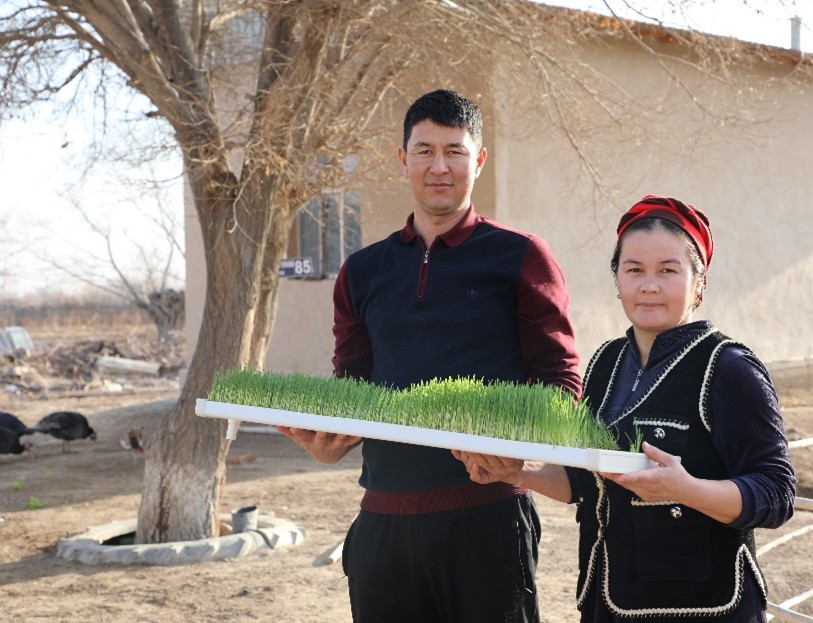Hydroponics Improving Life in Aral Sea Region

Hydroponics: A new opportunity for Women in the Aral Sea Region
Hydroponics Aral Sea Region | UNDP |
Have you ever thought about the possibility of growing plants without soil? This innovative technology, known as hydroponics, has been around for a long time, but it’s still a relatively new concept for many people. The idea behind hydroponics is to provide plants with nutrients directly through water, bypassing the need for soil.
Hydroponics was first introduced in the 19th century, and today it is widely used in the field of animal husbandry and poultry farming. This technology is especially in challenging environments like the Aral Sea region. This region presents unique challenges due to its ecological difficulties, but hydroponics offers a promising solution.
One of the main benefits of hydroponics is its efficiency in terms of time and resources. For example, the green mass of cereals, which is usually grown for weeks, can be obtained using hydroponics in just 5-7 days. The resulting green mass can then be used as a nutritious feed for livestock.
In addition, such feed products are rich in vitamins of group C, E, K and B, as well as elements such as iron and calcium, which strengthen the health of animals, increase their productivity and even have a positive effect on human health.
Since 2021, the UNDP has been gradually introducing hydroponics technology in six regions of the Aral Sea region. To date, 18 households have started using this modern method and have achieved positive changes in their lives.
How does this technology work in practice? What difficulties have the participants faced? Most importantly, how has this change affected people’s lifestyles? We will find out the answers to these questions from the stories of the brave women who are directly involved in the project – the women who grow their own food, strengthen their family’s food security, and earn an income.

Mahida Allaniyazova, 37 years old, Chimbay district
While engaged in parenting and household chores, Mahida found new opportunities in hydroponics. She tells:
“After learning about the possibility of growing green food using hydroponics, I decided to try. I have heard that such food is rich in vitamins, minerals and even contains estrogen-like substances that improve the reproductive functions of animals, increase milk yield and weight gain”.
Now Mahida grows green wheat feed right in her own home. The yields have increased significantly, and her family not only consumes eggs and dairy products, but also sells them, earning additional income.

Ulmeken Nisambayeva, 34 years old, Chimbay district
For Ulmeken, who lives in a family of eight and is struggling with unemployment, the project has become a real lifesaver:
“We have 8 people in our family. Due to the lack of work, I began to study hydroponics more deeply. Since our main source of income is animal farming, we had difficulty feeding our livestock. After hearing about the UNDP project, we decided to participate. Now we grow alfalfa using hydroponics, which has proven to be very effective”, says Ulmeken with pleasure.
The feed grown by the hydroponic method is not inferior in nutritional value to grain and ordinary green food. For example, when adding hydroponic green wheat grown in just 7 days to the diet of chickens, the total nutritional value of the feed increased by 13.4%, and the calcium content increased by 34%. This, in turn, had a positive effect on the quality of milk and eggs, which makes our heroine very happy.

Ilmira Pisenbayeva, 35 years old, Nukus district
Ilmira completed Bachelor’s and Master’s degrees in Foreign Languages at Berdak Karakalpak State University. During her maternity leave, she decided to take up hydroponics, as it benefits the whole family and helps replenish the family budget.
“After seeing information about the project on social media, I contacted the youth leader of the Nukus district and participated in the selection process organized by the UNDP. Since then, my husband and I have been growing alfalfa and corn”, Ilmira shares.
Ilmira noticed that the plants grew very quickly, and the feed was very nutritious. The chickens started to gain weight and lay eggs more frequently. Previously, it took 15-20 days for alfalfa to germinate, but with hydroponics it only took 5-6 days. In the future, they plan to sell the green fodder to local farmers. Ilmira says that hydroponics improves the enzymatic activity of the digestive system, and helps with digestion.
Hydroponics is not only a technological achievement, but also an effective way to adapt to climate change, improve the well-being of the local population and promote the economic independence of women. Moreover, the feed grown using this method helps to improve the digestion of animals and increases the absorption of nutrients.
However, the main advantage of this initiative is the people who implement it. Women who have benefited from hydroponics play a crucial role in the success of their families and the socio-economic growth of their communities.
The UNDP Project “The Project for Supporting Self-reliance through Climate-resilient Agriculture in the Aral Sea Region” is financed by the government of Japan and being implemented 2023-2025 and contribute to addressing multiple human insecurities of people, living in the most vulnerable districts of Karakalpakstan, which are fully aligned with the policies and strategies of the Government of Uzbekistan on addressing the Aral Sea crises.
The post Hydroponics Improving Life in Aral Sea Region appeared first on GROZINE.

